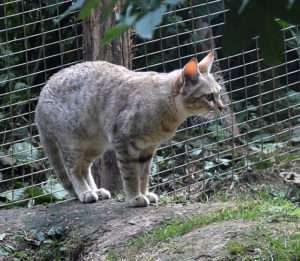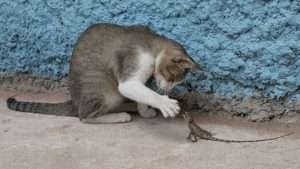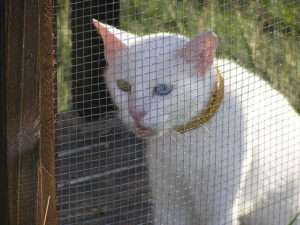 Cats are wonderful animals and I love them dearly; they’re incredible companions, highly entertaining, and there are few things nicer than having a content, purring cat curled up next to you (or using you as a pillow.) However, I have to balance my appreciation of these sweet and mischievous felines with the reality that they can also be quite ecologically destructive. An indoor/outdoor or outdoor cat is especially problematic for a variety of reasons, and unfortunately they have a lot of apologists. So I feel the need to pick apart a few of the myths people use to justify allowing cats to free-roam outside.
Cats are wonderful animals and I love them dearly; they’re incredible companions, highly entertaining, and there are few things nicer than having a content, purring cat curled up next to you (or using you as a pillow.) However, I have to balance my appreciation of these sweet and mischievous felines with the reality that they can also be quite ecologically destructive. An indoor/outdoor or outdoor cat is especially problematic for a variety of reasons, and unfortunately they have a lot of apologists. So I feel the need to pick apart a few of the myths people use to justify allowing cats to free-roam outside.
Why is it so important to point these issues out? Cats are incredibly dangerous to wildlife; in fact, they are the single biggest human-related cause of bird mortality–more than pollution, windmills, poaching, and other causes. They also slaughter 2.4 billion birds in the United States every year, along with 5-12 billion native mammals, reptiles, and amphibians, and that’s not even getting into their impact in the rest of the world. I’ve written at length about this issue in this article here, so I won’t elaborate further here. Let’s dig into some of those justifications and myths from outdoor cat advocates.
It’s natural for them to hunt so we should allow them to roam free: Well, yes. Cats and dogs both often retain significant prey drive from their wild ancestors. That’s why even at a young age a kitten will happily chase a toy, a bug, or even another cat, and even the nicest cat may occasionally decide to go after your ankles, claws out.

But retaining those instincts does not make an outdoor cat a wild animal. The domesticated cat, Felis catus, is not the same species as its ancestor, the African wildcat (Felis lybica) any more than a domesticated cow (Bos taurus) is the same as the now-extinct wild aurochs (Bos primigenius). Domestication has significant physical and behavioral effects on a species, and while a housecat may seem to have its wild moments and feral domestic cats can be incredibly avoidant, the domestic cat is still a much tamer and more human-oriented animal than a wildcat.
The most important factor to keep in mind is that domestic cats are not native to any ecosystem in the world, not even the same ecosystems inhabited by African wildcats. Many of the places where cats are now found do not naturally have a small cat occupying an ecological niche, and the prey animals and other species there are not adapted to the sudden introduction of cats. Cats have caused the extinction of over five dozen species, and are driving hundreds more toward that same sad fate. Moreover, in places that do still have small wildcats, these native species are threatened by disease transmission and interbreeding from domesticated cats.
My cat never brings home birds or other animals! So? That doesn’t mean they aren’t still out there killing wildlife. Cats only bring home a fraction of the animals they kill, and many of them don’t even end up eaten, but discarded instead. In fact, they engage in so much surplus killing that the impact of one cat may be four to ten times greater than that of one wild predator. That means that for every one prey animal a wild animal may kill and eat, a cat may slaughter ten more for the fun of it.

Even if your cat just seems to lazily hang around the yard, that doesn’t mean they aren’t still a danger to wildlife. That includes insects and other invertebrates which in many ways are even more important to a local ecosystem than the mammals and other vertebrates. And keeping your cat outside sends a message to other people that this is a normal and acceptable practice, which means your neighbors may feel more justified in allowing their more murderous cats to rampage all over the area.
They keep rat and mouse populations down: While your cat may bring home a mouse now and then, they really aren’t as effective at rodent control as people’s confirmation bias makes them want to think. For one thing, even a feral outdoor cat isn’t likely to go after a rat, but will prefer smaller, easier prey. And while the presence of a cat may sometimes deter rodents, this isn’t going to make as much of a difference in places a cat doesn’t have access to, such as inside your walls.
Moreover, not every cat is interested in hunting rodents. Cats tend to learn from their mothers what and how to hunt, and if the mama cat largely goes after birds, that’s what the kittens will likely focus on as they get older.
Finally, every mouse, bird, or other native prey animal killed by a domestic cat is one less prey animal that native predators like foxes and bobcats have access to. Given the higher rate of surplus killing cats do, they are dangerous not just for the prey, but for hungry predators missing out on meals, too. (Plus a predator that doesn’t have a full belly of mice and voles may be more tempted to make a meal out of a cat.)
My cat hates being indoors: That’s just too bad, then, isn’t it. When you take on an animal as a pet, it’s your responsibility to make sure its needs are met. Just opening the door and letting your cat run out into the world unattended is irresponsible on a wide range of levels. In addition to the havoc they wreak on the local ecosystem, an outdoor cat runs risks like getting splattered by cars, torn up by dogs, eaten by coyotes and other wild predators, poisoned by antifreeze, plants, or poisoned rodents, stolen by people with cruel intentions, trapped in storm drains and other dangers, infected by diseases, being miserable in heat, cold, and rain, and otherwise subjected to threats that lead to a much shorter lifespan (two to five years is about average for an outdoor cat.) I have seen more than one family who just went to the shelter every couple of years and got another cat every time something happened to the last one, and then tossed the newcomer outside to fend for themselves.
If your cat isn’t happy indoors, then it’s your job to fix that. Enrichment and training are the two big keys. There are so many ways to make even a small apartment more appealing to a cat with things to climb on, hide in, and play with. Rotating toys around so the cat isn’t getting bored with the same ones helps a lot, and bringing home something new can be a great way to brighten your cat’s day. Stressed cats may also be able to be calmed with pheremone products like Feliway. And if you have a lone cat, they might benefit from you adopting a buddy for them (though some cats prefer to be only children.) And yes, cats can be trained, including to do tricks! Just as with dogs, learning new things can add tons of mental stimulation and fun to your cat’s life.
 A largely indoor cat can still enjoy the outdoors when supervised. People who have porches or yards may build a catio that allows them to have some outdoor time while being protected and able to go back inside. (It keeps the local wildlife safe, too–your cat can chirp and lash its tail all they want when a bird goes by, but they can’t harm it.) Cats can even be leash-trained! It may take some patience, especially with an older cat or one who has been accustomed to unsupervised outdoor time, but it can be done. If you’re starting with a kitten, train them early and they’ll take to it a lot easier. And who doesn’t want to have a cat who would happily ride on your shoulder while safely exploring the world with you?
A largely indoor cat can still enjoy the outdoors when supervised. People who have porches or yards may build a catio that allows them to have some outdoor time while being protected and able to go back inside. (It keeps the local wildlife safe, too–your cat can chirp and lash its tail all they want when a bird goes by, but they can’t harm it.) Cats can even be leash-trained! It may take some patience, especially with an older cat or one who has been accustomed to unsupervised outdoor time, but it can be done. If you’re starting with a kitten, train them early and they’ll take to it a lot easier. And who doesn’t want to have a cat who would happily ride on your shoulder while safely exploring the world with you?
Well, I’ve had X number of outdoor cats that lived to be Y years old! Okay, great. That doesn’t mean that every outdoor cat lives a long, healthy life. Most people I know who have made this sort of claim have had at least a couple cats that ended up run over by cars or simply disappearing, and I would be willing to bet others had some in their past that they simply don’t want to mention.
We’ve always done it this way: And? Your point is? Just because that’s the way you’ve always done something doesn’t mean that you have to keep doing things that way. I care for my pets very differently from how my family did when I was growing up in the 1980s. I have access to a lot more information now than then, and while I know we did our best back then, I feel I’ve definitely improved in a lot of ways.
It’s not only normal to assess how you do things now and then, but it’s healthy! Many animals are harmed by outdated care methods, and with widespread access to the internet people have more opportunities than ever to learn about better alternatives. We now know just how harmful the life of an outdoor cat can be, both to themselves and to other living beings, including native wildlife, and the very best thing we can do for our cats is keep them safely indoors.
Did you enjoy this post? Consider taking one of my online foraging and natural history classes or hiring me for a guided nature tour, checking out my other articles, or picking up a paperback or ebook I’ve written! You can even buy me a coffee here!
